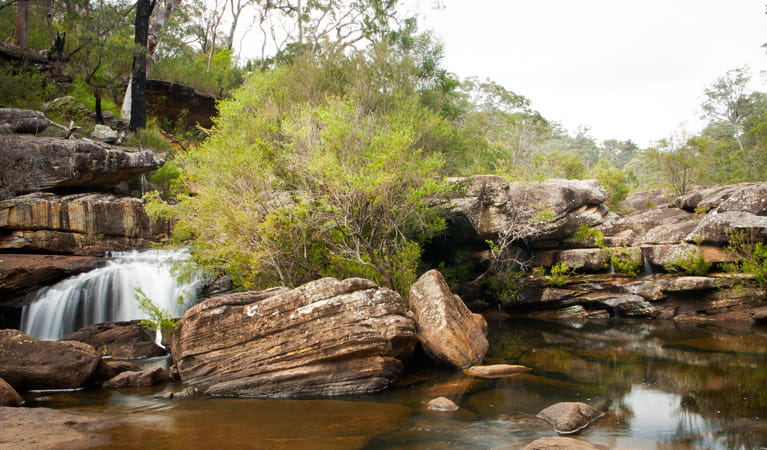Dharawal National Park
Overview
Walking and bike tracks, waterfalls and rock pools; Dharawal National Park near Helensburgh, an important place for Aboriginal people, is a great place to spend the day.
Read more about Dharawal National Park
Dharawal National Park offers a diverse bushland experience in southern Sydney. Sustained by a distinctive network of creeks, including the ecologically-important O'Hares Creek catchment, this leafy park is of great significance to the Dharawal Aboriginal people and protects a number of special Aboriginal sites.
The park’s ancient landscape is a contrast of tall eucalypts, heaths, swamps, waterfalls and rockpools. There’s plenty to see and do for the day; take a short walk to Maddens Falls, stop by Stokes Creek for a swim and picnic lunch or ride your mountain bike along one of the park’s trails. Dharawal National Park is one of NSW's newest, so NPWS is working to provide additional low key facilities for your enjoyment.
Don’t forget to keep an eye out for wildlife among the eucalypt trees, frogs and the diverse birdlife flitting through the park’s trees, swamps and skies.
Local alerts
For the latest updates on fires, closures and other alerts in this area, see https://www.nationalparks.nsw.gov.au/visit-a-park/parks/dharawal-national-park/local-alerts
Map
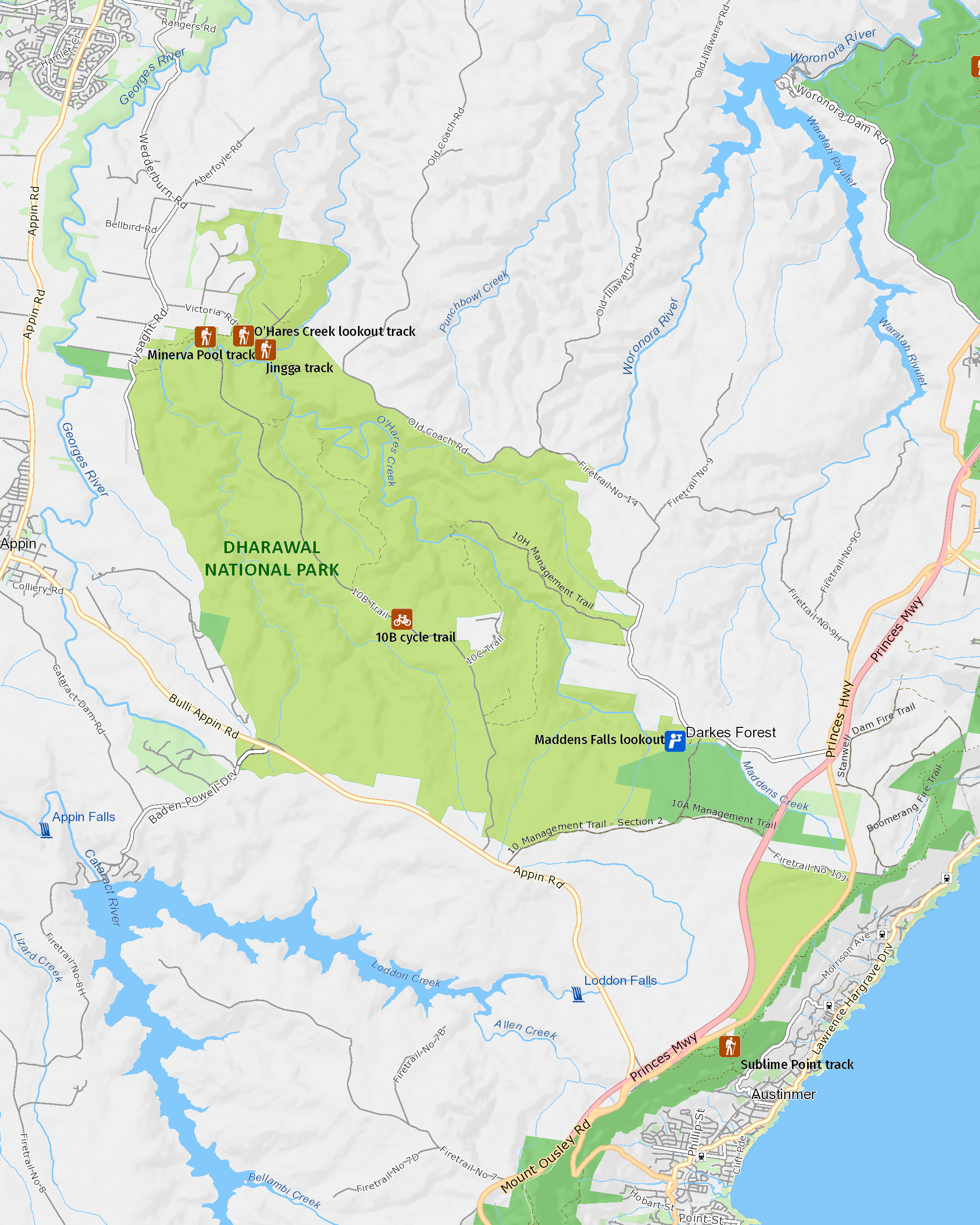
Map legend

Contact
- in the Sydney and surrounds and South Coast regions
Dharawal National Park is always open but may have to close at times due to poor weather or fire danger.
-
-
Wollongong office
02 4224 4188
Contact hours: Monday to Friday, 8.30am to 4.30pm. - Unit G Ground Floor, 84 Crown Street, Wollongong NSW 2500
-
Email: npws.illawarrahighlands@environment.nsw.gov.au
-
Wollongong office
Visitor info
All the practical information you need to know about Dharawal National Park.
Getting there and parking
Get driving directions
You can access the park through any of three entry points.
From Helensburgh to the park’s eastern entry, turn left onto Old Princes Highway/State Route 60. Turn right onto Darkes Forest Road and continue along to the park entry at Maddens Falls.
From Campbelltown to the park’s northwestern entry, head south on Wedderburn Road, then turn right onto Minerva Road. Continue onto Lysaght Road, and turn left onto Victoria Road and continue to the park entry.
From Bulli Tops to the park’s southern entry, head north on Appin Road/State Route 69 and continue towards Fire Road. You can access the park from the locked gate for the 10B management trail.
Parking
- Minerva Pool walking track See on map
Road quality
- Sealed roads
Vehicle access
- 2WD vehicles
By bike
Check out the Bicycle information for NSW website for more information.
Best times to visit
Dharawal National Park is a great place to visit all year round. Head to the park for a refreshing dip during summer, a weekend picnic in the winter sun, some wildflower spotting during spring or an autumn walk or bike ride.
Weather, temperature and rainfall
Summer temperature
Average
17°C and 26°C
Highest recorded
42°C
Winter temperature
Average
6°C and 16°C
Lowest recorded
-0.6°C
Rainfall
Wettest month
March
Driest month
September
The area’s highest recorded rainfall in one day
254.5mm
Facilities
Maps and downloads
Prohibited
Pets
Pets and domestic animals (other than certified assistance animals) are not permitted. Find out which regional parks allow dog walking and see the pets in parks policy for more information.
Smoking
NSW national parks are no smoking areas.
Nearby towns
Campbelltown (14 km)
For nature lovers, the Macarthur region has plenty of natural attractions. Explore nature reserves and wildlife trails or see spectacular native flora and fauna at the Australian Botanic Garden Mount Annan, the largest botanic garden in Australia.
Appin (22 km)
Follow the 'Burragorang and Bushrangers' drive from Picton through Oakdale, Nattai, The Oaks, Mount Hunter and then via Razorback Lookout to Picton.
Wollongong (30 km)
There are plenty of opportunities for adventure activities in and around Wollongong ranging from surfing and swimming to sailing, hang gliding, paragliding, cycling and abseiling. Wollongong is the only place in NSW where you can skydive onto the beach.
Learn more
Dharawal National Park is a special place. Here are just some of the reasons why:
Park history
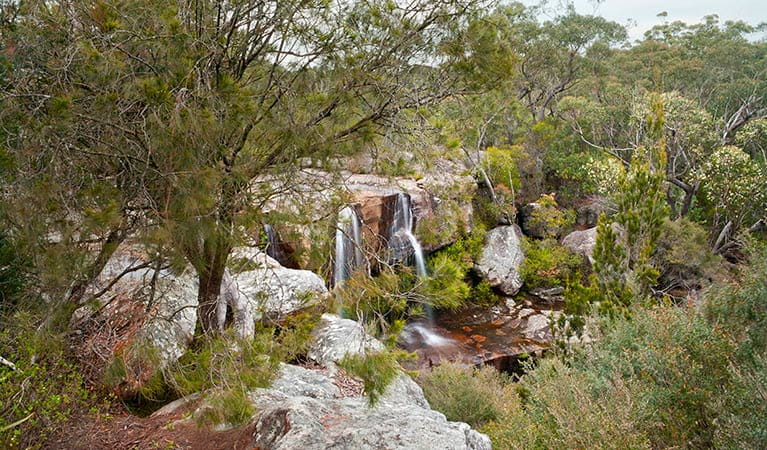
Dharawal was proclaimed a national park in 2012 following significant community involvement. Previously, it operated as a state conservation area and, before this, a water catchment area managed by Sydney Water. Seventy years of restricted public access has kept the area largely undisturbed, so pristine surroundings await you on your visit.
Inspiring scenery
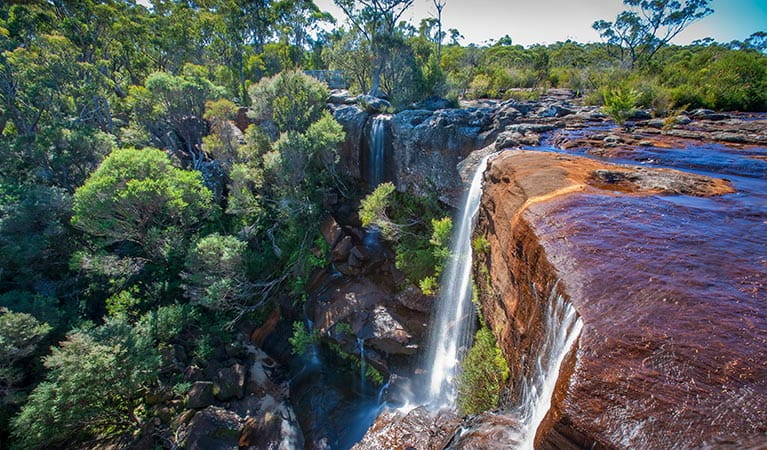
Prepare to be awed by the beautiful dense vegetation and rugged Hawkesbury sandstone that dominates the park's landscape. Set off on a bushwalk to discover eucalypt and shale forests, stunted woodlands and windswept heath. Explore further to find patches of rainforest and extensive sedgeland amongst the scenic terrain.
- 10B cycling trail 10B cycling trail in Dharawal National Park offers excellent easy cycling for enthusiastic bike riders, with a picturesque picnic spot along the way.
- Minerva Pool walking track Minerva Pool walking track winds through the traditional country of the Aboriginal Dharawal People. Enjoy a short bushwalk and then picnic at Minerva Pool, in Dharawal National Park, near Campbelltown.
- O'Hares Creek lookout For great gorge views near Campbelltown and Wollongong in southern Sydney, O'Hares Creek lookout in Dharawal National Park offers breathtaking scenery and birdwatching along a family-friendly walking track.
Ancient landscapes
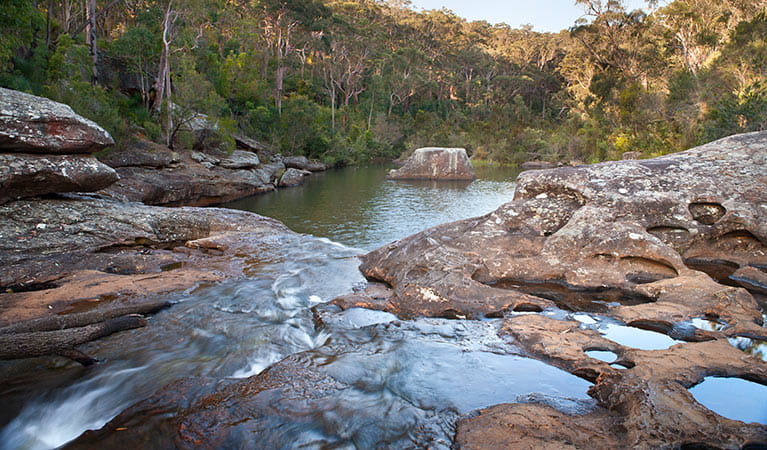
Dharawal National Park is the traditional land of the Dharawal Aboriginal people. Their long connection with this Country; the land and waterways, and the plants and animals that live in it feature in all facets of Aboriginal culture and are associated with Dreaming stories and cultural learning that is passed on today. The park protects several ancient Aboriginal sites, including drawings and axe-grinding grooves.
- Jingga walking track Jingga walking track, in Dharawal National Park, is a short yet challenging walk to a waterhole, offering picnic and birdwatching opportunities.
- Minerva Pool walking track Minerva Pool walking track winds through the traditional country of the Aboriginal Dharawal People. Enjoy a short bushwalk and then picnic at Minerva Pool, in Dharawal National Park, near Campbelltown.
A crucial catchment
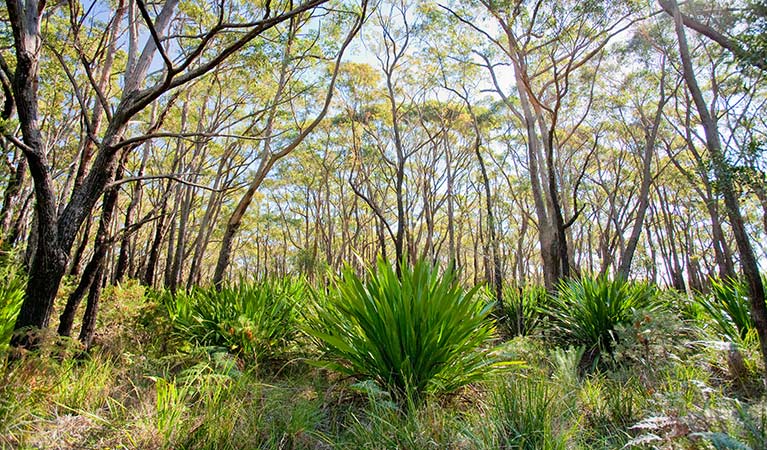
O'Hares Creek catchment, on the Register of the National Estate is home to 17 vulnerable, rare or threatened species, and feeds the park's eucalypt forest, woodland, heathland, and sedgeland habitats. More than 500 plant species occur within the park, providing a home to a wide range of animals, including koalas and long-nosed potoroos, swamp wallabies, eastern wallaroos, New Holland honeyeaters and countless birds.
- Maddens Falls Enjoy scenic waterfall views at Maddens Falls lookout near Helensburgh, a great reward after a long bushwalk and the perfect place for birdwatching and photography.
- O’Hares Creek lookout walking track Gather the family and head to O’Hares Creek lookout walking track in Dharawal National Park, south of Campbelltown and near Appin. It’s a great getaway with scenic views and birdwatching.
Plants and animals protected in this park
Animals
-

Swamp wallaby (Wallabia bicolor)
The swamp wallaby, also known as the black wallaby or black pademelon, lives in the dense understorey of rainforests, woodlands and dry sclerophyll forest along eastern Australia. This unique Australian macropod has a dark black-grey coat with a distinctive light-coloured cheek stripe.
-
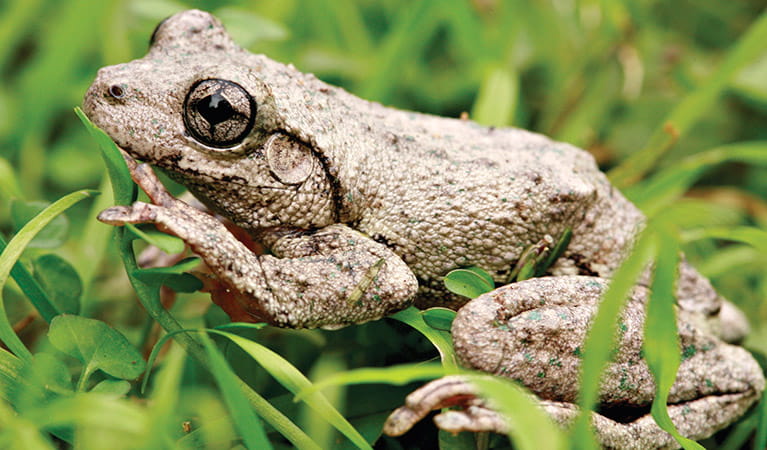
Peron's tree frog (Litoria peroni)
Peron’s tree frog is found right across NSW. These tree-climbing and ground-dwelling Australian animals can quickly change colour, ranging from pale green-grey by day, to a reddish brown with emerald green flecks at night. The male frog has a drill-like call, which has been described as a 'maniacal cackle’.
-
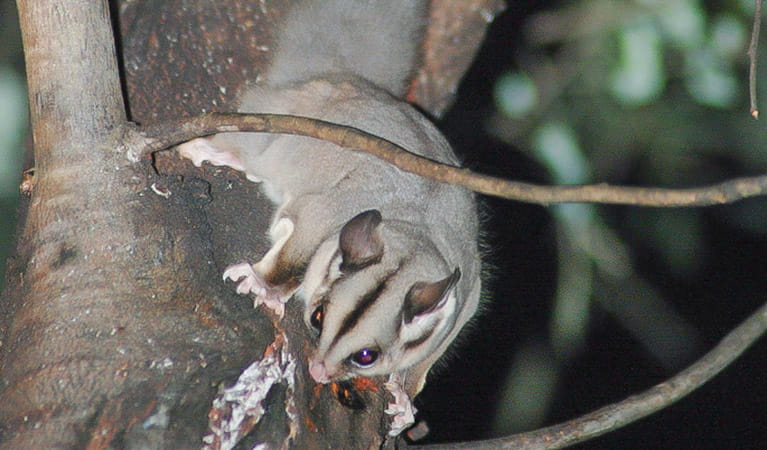
Sugar glider (Petaurus breviceps)
The sugar glider is a tree-dwelling Australian native marsupial, found in tall eucalypt forests and woodlands along eastern NSW. The nocturnal sugar glider feeds on insects and birds, and satisfies its sweet tooth with nectar and pollens.
-

Southern boobook (Ninox novaeseelandiae)
The southern boobook, also known as the mopoke, is the smallest and most common native owl in Australia. With a musical 'boo-book' call that echoes through forests and woodlands, the southern boobook is a great one to look out for while bird watching.
-
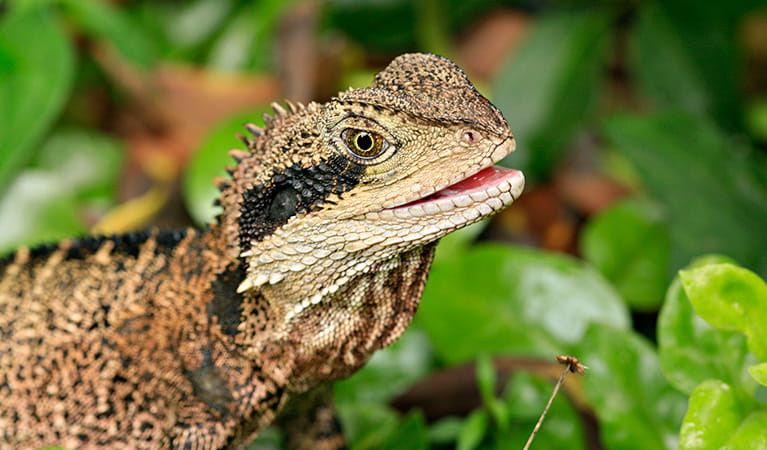
Eastern water dragon (Intellagama lesueurii lesueurii)
The eastern water dragon is a subaquatic lizard found in healthy waterways along eastern NSW, from Nowra to halfway up the Cape York Pensinsula. It’s believed to be one of the oldest of Australian reptiles, remaining virtually unchanged for over 20 million years.
Environments in this park
Education resources (1)
What we're doing
Dharawal National Park has management strategies in place to protect and conserve the values of this park. Visit the OEH website for detailed park and fire management documents. Here is just some of the work we’re doing to conserve these values:
Preserving biodiversity
NPWS aims to protect the biodiversity of all parks, and Dharawal National Park is no exception. Surveying and monitoring programs in place to protect the park's threatened, endangered, vulnerable and special-interest plants and animals. These programs assist research into the distribution, habitat requirements and threats to species, populations and ecological communities within the park.
Managing weeds, pest animals and other threats
Pests and weeds have a significant impact to the ecosystems within Dharawal National Park. Risk assessments for new and emerging weeds are carried out as an ongoing initiative within the park. Pest management is an important part of the work NPWS does to protect the integrity of biodiversity which exists within the area.
Developing visitor facilities and experiences
Dharawal National Park works to keep its visitors safe and informed, and this extends to issues of access and signage. Displaying up to date, easily understandable signage is an ongoing priority in this park. Maintenance of and enhancements to facilities and infrastructure such as roads, walking tracks and viewing platforms are also carried out in this national park.
Conserving our Aboriginal culture
Dharawal National Park boasts a proud legacy of Aboriginal culture. Ongoing NPWS projects are in place to audit, monitor and maintain the condition of the park's Aboriginal sites and assets. NPWS works in conjunction with the Tharawal Local Aboriginal Land Council and other relevant Aboriginal representatives to facilitate this, and works to ensure sites are appropriately recognised, supported and conserved.
Managing fire
NSW is one of the most bushfire prone areas in the world as a result of our climate, weather systems, vegetation and the rugged terrain. NPWS is committed to maintaining natural and cultural heritage values and minimising the likelihood and impact of bushfires via a strategic program of fire research, fire planning, hazard reduction, highly trained rapid response firefighting crews and community alerts.

